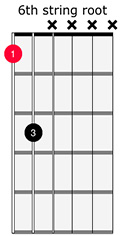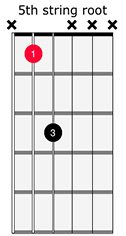So many players make a living with power chords. Genres like metal and punk have made them an integral part of guitar playing over the years. Powerchords are comprised of only two notes: the root and the perfect fifth. They are neither major nor minor. Because of this structure, the sound they produce is simple, clean, and powerful. Hence the name. Throw on some nice distortion and they're just red hot.
Powerchords are best learned as movable shapes. This means that your fingers keep the same shape and move up and down the fretboard to make the different chords. Below I have made diagrams of three basic powerchord shapes with roots on the sixth, fifth, and fourth strings. The root is the name of the chord. For example, if you are playing a G powerchord the root is G.
The next thing we need to do is to map out the roots on the fretboard so you can find powerchords all over the neck. Take note of your fretboard markers (the dots). These are very useful when navigating the fretboard. Memorize their location and corresponding roots on each string. Notice that there is no note between B and C as well as E and F. All of the other blank spaces are called accidentals, or sharps and flats, as we learned before.
If you are trying to sound a B powerchord with the root on the sixth string, for example, you would play B on the seventh fret with the first finger as well as an F# with your third finger on the fifth string on the ninth fret. I want you to be able to find and play all of the chords (A - G#) with roots on the sixth, fifth, and fourth string.
Now let's incorporate these into our playing. Refer back to all of the basic transitions we used in lesson four and play these with powerchords. Obviously, since powerchords are neither major nor minor, disregard all the tonality differences and focus on the root movement. I want you to try each of these transitions in three different spots on the neck. Specifically, I want you to start on a different root each time and find your closest, most economical move.


